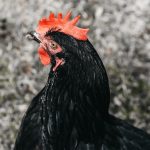Keeping separate chicken breeds is a practice that has been followed by poultry enthusiasts and farmers for centuries. It involves maintaining distinct breeds of chickens in separate coops or enclosures to preserve their unique characteristics and traits. This practice is important for maintaining the purity of each breed and preventing crossbreeding, which can result in the loss of desirable traits and genetic diversity.
By keeping chicken breeds separate, breeders can ensure that each breed remains true to its standard and can continue to contribute to the diversity of the poultry population. Maintaining separate chicken breeds also allows breeders to focus on improving specific traits within each breed without the risk of diluting those traits through crossbreeding. This can lead to the development of superior lines within each breed, whether it be for egg production, meat quality, or ornamental purposes.
Additionally, keeping chicken breeds separate can help prevent the spread of diseases and parasites between different breeds, as well as reduce the risk of aggression and competition among birds of different breeds. Overall, keeping separate chicken breeds is a fundamental practice for preserving the integrity and diversity of poultry breeds.
Table of Contents
- 1 Importance of keeping chicken breeds separate
- 2 Tips for keeping chicken breeds separate
- 3 Potential problems and challenges of keeping chicken breeds separate
- 4 Benefits of keeping chicken breeds separate
- 5 Conclusion and final thoughts on keeping chicken breeds separate
- 6 Resources for further information on keeping chicken breeds separate
- 7 FAQs
- 7.1 What is the purpose of keeping breeds of chickens separate?
- 7.2 How can I keep breeds of chickens separate?
- 7.3 Why is it important to prevent crossbreeding between chicken breeds?
- 7.4 What are the benefits of keeping breeds of chickens separate?
- 7.5 Are there any challenges associated with keeping breeds of chickens separate?
Key Takeaways
- Keeping separate chicken breeds can help maintain breed purity and prevent crossbreeding.
- It is important to keep chicken breeds separate to preserve their unique characteristics and traits.
- Tips for keeping chicken breeds separate include providing separate living spaces, feeding areas, and breeding pens.
- Potential problems and challenges of keeping chicken breeds separate include the need for extra space and resources.
- Benefits of keeping chicken breeds separate include the ability to selectively breed for specific traits and maintain breed standards.
- In conclusion, keeping chicken breeds separate is essential for preserving breed integrity and diversity.
- Resources for further information on keeping chicken breeds separate include breed-specific organizations, online forums, and books on poultry keeping.
Importance of keeping chicken breeds separate
Preserving Genetic Diversity
This is crucial for maintaining a healthy and sustainable poultry population, as genetic diversity is essential for the long-term survival and adaptability of chicken breeds.
Improving Breed-Specific Traits
Furthermore, keeping chicken breeds separate allows breeders to focus on improving specific traits within each breed without the risk of dilution through crossbreeding. This can lead to the development of superior lines within each breed, whether it be for egg production, meat quality, or ornamental purposes.
Reducing Disease and Aggression Risks
Additionally, maintaining separate breeds can help prevent the spread of diseases and parasites between different populations, as well as reduce the risk of aggression and competition among birds of different breeds.
Overall, keeping chicken breeds separate is vital for preserving the integrity and diversity of poultry breeds and ensuring the long-term sustainability of the poultry industry.
Tips for keeping chicken breeds separate

When it comes to keeping chicken breeds separate, there are several important tips to keep in mind. Firstly, it is essential to provide separate coops or enclosures for each breed to prevent crossbreeding and ensure that each population remains distinct. This can be achieved by building separate housing units or using dividers within a larger coop to create distinct living spaces for each breed.
Additionally, it is important to provide separate feeding and watering stations for each breed to prevent competition and ensure that all birds have access to adequate nutrition. Furthermore, it is crucial to implement strict biosecurity measures to prevent the spread of diseases and parasites between different populations. This can include regular cleaning and disinfection of coops, as well as limiting contact between birds of different breeds.
Additionally, it is important to monitor the health and behavior of each breed closely to detect any signs of illness or stress early on. Finally, it is essential to keep detailed records of each breed’s lineage and breeding history to maintain the purity and integrity of each population. By following these tips, breeders can effectively keep chicken breeds separate and preserve their unique characteristics and traits.
In addition, it is important to consider the space requirements for each breed when keeping them separate. Some breeds may require more space than others due to their size or activity level, so it is important to provide adequate space for each breed to ensure their physical and mental well-being. Additionally, providing enrichment activities such as perches, dust baths, and toys can help prevent boredom and reduce stress among birds in separate populations.
Finally, it is important to consider the social dynamics within each breed and provide opportunities for socialization and interaction with other birds of the same breed to promote healthy behavior and development.
Potential problems and challenges of keeping chicken breeds separate
While keeping chicken breeds separate is important for preserving their unique characteristics and genetic diversity, there are several potential problems and challenges that breeders may encounter. One common challenge is the risk of accidental crossbreeding, which can occur if birds from different breeds are allowed to mingle or if there are gaps or weaknesses in the physical barriers between populations. This can result in the loss of desirable traits and genetic diversity within each breed, as well as create confusion regarding the lineage and purity of individual birds.
Another potential problem is the increased workload and management required to maintain multiple separate populations of chickens. This can include the need for additional housing, feeding, and cleaning routines, as well as the need for careful record-keeping and monitoring of each population. Additionally, maintaining strict biosecurity measures to prevent the spread of diseases and parasites between different populations can be challenging and require careful attention to detail.
Furthermore, keeping chicken breeds separate can also lead to increased costs associated with providing adequate space, resources, and enrichment activities for each population. This can be particularly challenging for small-scale breeders or hobbyists with limited resources or space. Additionally, maintaining social dynamics within each population and preventing loneliness or boredom among birds can be challenging without careful planning and management.
Benefits of keeping chicken breeds separate
Despite the potential problems and challenges, there are numerous benefits to keeping chicken breeds separate. One of the primary benefits is the preservation of the unique characteristics and genetic diversity of each breed. By maintaining distinct populations, breeders can ensure that each breed remains true to its standard and can continue to contribute to the overall diversity of poultry.
This is essential for maintaining a healthy and sustainable poultry population with a wide range of traits and adaptations. Additionally, keeping chicken breeds separate allows breeders to focus on improving specific traits within each breed without the risk of dilution through crossbreeding. This can lead to the development of superior lines within each breed, whether it be for egg production, meat quality, or ornamental purposes.
Furthermore, maintaining separate populations can help prevent the spread of diseases and parasites between different populations, as well as reduce the risk of aggression and competition among birds of different breeds. Moreover, keeping chicken breeds separate can also provide opportunities for education and outreach about the importance of preserving genetic diversity and heritage breeds. By showcasing distinct populations of chickens with unique characteristics and traits, breeders can raise awareness about the value of maintaining diverse poultry populations and inspire others to get involved in conservation efforts.
Conclusion and final thoughts on keeping chicken breeds separate

Benefits of Keeping Chicken Breeds Separate
While there are potential problems and challenges associated with keeping chicken breeds separate, such as accidental crossbreeding and increased management requirements, the benefits far outweigh these challenges. Preserving genetic diversity, improving specific traits within each breed, preventing disease spread, reducing aggression among birds, and providing educational opportunities are just a few of the many benefits associated with keeping chicken breeds separate.
Challenges and Considerations
However, breeders must also consider the potential challenges and problems that can arise when keeping chicken breeds separate. These may include accidental crossbreeding, increased management requirements, and ensuring adequate space and resources for each breed.
Effective Strategies for Keeping Chicken Breeds Separate
To overcome these challenges, breeders can implement effective strategies such as providing separate housing and resources for each breed, implementing strict biosecurity measures, considering space requirements and social dynamics, and ensuring adequate management and care for each breed. By following these tips, breeders can effectively keep chicken breeds separate and preserve their unique characteristics and traits.
Resources for further information on keeping chicken breeds separate
For further information on keeping chicken breeds separate, there are numerous resources available to poultry enthusiasts and breeders. The American Poultry Association (APA) provides valuable information on breed standards, breeding practices, and conservation efforts for a wide range of poultry breeds. Additionally, organizations such as The Livestock Conservancy offer resources on heritage breeds conservation and preservation efforts.
Books such as “Storey’s Guide to Raising Chickens” by Gail Damerow provide comprehensive information on all aspects of raising chickens, including breeding practices and maintaining distinct populations. Online forums such as BackYardChickens.com also offer a wealth of knowledge from experienced poultry enthusiasts who can provide advice on keeping chicken breeds separate. Furthermore, attending poultry shows and exhibitions can provide valuable opportunities to learn about different breeds and network with other breeders who are passionate about preserving genetic diversity in poultry populations.
Overall, there are numerous resources available for those interested in learning more about keeping chicken breeds separate and contributing to conservation efforts within the poultry industry.
If you’re interested in learning more about keeping chickens separate, you might also want to check out this article on creating a chicken coop in Chester, SC. It offers valuable insights into the design and maintenance of a coop that can help keep your chickens safe and separate when needed.
FAQs
What is the purpose of keeping breeds of chickens separate?
Keeping breeds of chickens separate is important for maintaining the purity of the breed. It helps to prevent crossbreeding and ensures that the desirable traits of each breed are preserved.
How can I keep breeds of chickens separate?
You can keep breeds of chickens separate by providing separate living spaces, such as coops and runs, for each breed. This will prevent them from intermingling and potentially crossbreeding.
Why is it important to prevent crossbreeding between chicken breeds?
Preventing crossbreeding between chicken breeds is important for maintaining the integrity of each breed. Crossbreeding can result in mixed or diluted traits, which can impact the breed’s standard characteristics and overall quality.
What are the benefits of keeping breeds of chickens separate?
Keeping breeds of chickens separate allows breeders to maintain the purity of each breed, preserve specific traits, and uphold breed standards. It also helps to prevent accidental crossbreeding and ensures that each breed remains true to its original characteristics.
Are there any challenges associated with keeping breeds of chickens separate?
One challenge of keeping breeds of chickens separate is the need for adequate space and resources to accommodate multiple coops and runs. Additionally, careful management and monitoring are required to prevent accidental intermingling of breeds.
Meet Walter, the feathered-friend fanatic of Florida! Nestled in the sunshine state, Walter struts through life with his feathered companions, clucking his way to happiness. With a coop that’s fancier than a five-star hotel, he’s the Don Juan of the chicken world. When he’s not teaching his hens to do the cha-cha, you’ll find him in a heated debate with his prized rooster, Sir Clucks-a-Lot. Walter’s poultry passion is no yolk; he’s the sunny-side-up guy you never knew you needed in your flock of friends!







